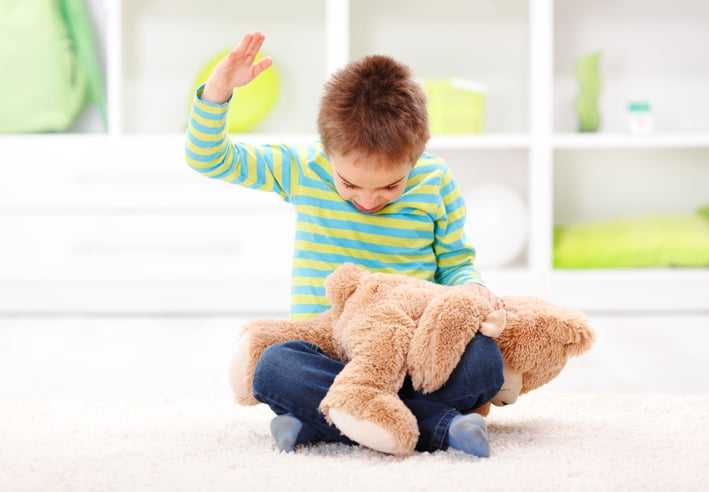Autism and Aggression: A Four-Step Approach
How to deal with aggressive behavior remains one of the main and most urgent questions teachers and caregivers of autistic children ask, and aggression is also among the most common challenges conveyed by parents and primary carers of children and adolescents with autism.
As with all challenging behaviors, it is important to remember that behavior is communication. A child does not act out just for the sake of acting out. There is always a reason and function for challenging behavior. So how can we help?

A Four-Step Approach
Here is a four-step approach to address aggression and other challenging behaviors:
STEP 1
Identifying the behavior
First, take some time to identify and describe the behavior. What type of aggression does the child display? Do they hit, kick, or bite? Do they try to hurt themselves? When does the behavior happen? Where does it occur? Does the child act out only in a certain place, or at a certain time? Writing down the answers to some of these questions can provide important clues as to what may be triggering the aggression. It is also important for parents and teachers to communicate when aggressive behavior is in play, to compare notes, and to get each other’s input.
STEP 2
Understanding the behavior
Once we have a clear picture of what the behavior looks like, and where and when it happens, we can start looking at why the behavior occurs. Autistic children may behave aggressively or hurt themselves because they…
- may have a hard time understanding what’s happening around them, or what other people are saying or communicating non-verbally.
- may have difficulty communicating their wants and needs.
- may be very anxious and stressed.
- may have sensory issues, such as an oversensitivity to sound, or a need for sensory input.
- may want to escape from stressful situations or activities.
To find out the reason and function of the behavior, we will have to play detective. Is the child upset because they can’t have something they want? Does the child display aggression during an exceptionally loud assembly? Is the assignment the child is working on too hard for them? Is the child not feeling well? There can also be other underlying problems that can trigger aggression in autistic children. A break in routine, lack of sleep, gastrointestinal or other medical issues, and certain noises, smells or bright lights can trigger aggressive behavior.
STEP 3
Preventing the behavior
Once we identify and understand the function of a behavior, one of the first things we can do is modify their surroundings to accommodate any special needs the child may have. For example, creating a calm, predictable, and rewarding environment can help. Using visual supports and structured schedules, which promote smooth transitions between activities, is also very effective. Eliminating or minimizing sensory triggers by providing noise-dampening headphones, dimming the lights, and reducing overstimulating décor in the classroom can also prevent an autistic student from melting down.
Once we correct any environmental triggers, we can start teaching the child a better way to communicate needs and provide positive reinforcement to reward positive and desirable behavior. Prepare and present individualized picture stories of an appropriate replacement behavior when the child is calm and ready to learn. Review these stories consistently every day, or several times a day before a specific behavior occurs. If the child feels embarrassed to review the story or rules in front of others, find a private place or time to do so. Refer to the story positively and praise and reward the child as often as you catch them following the rules and demonstrating acceptable behavior.
Stages Learning Emotions Education Products

STEP 4
Managing the behavior
No matter how much we try to prevent aggressive behavior, even the best planner in the world can’t predict every scenario that may unfold. All we can do is try our best to prevent the unexpected while giving the children in our care the real-life awesome experiences they need and deserve. Because it is common for autistic children to behave aggressively toward themselves or others, it is important to have a plan in place for handling the unpredicted meltdown.
Here are some things you can do if a meltdown or aggression does occur:
Consider safety:
The first and most important thing to do is to make sure the child is safe by checking their immediate environment and ensuring that there is nothing around them that can cause harm to them or others. Move sharpened pencils and scissors out of reach and remove heavy objects a child may try to hurl. You may have to move the child to a safe place, and if other children are in the vicinity, make sure they are safe as well. Keep yourself safe also, and position yourself in such a way that you will not be backed into a corner or against a wall. Always make sure you can move out of harm’s way.
Stay calm:
It is very important to stay very calm and quiet when an autistic child escalates into a meltdown and/or becomes aggressive. Most aggressive outbursts happen because a child’s feelings have built up and they cannot communicate them. By managing your feelings and staying calm and quiet, you won’t add your own emotions to the mix. Autistic children sense and feed off your energy, and when you remain calm it can help de-escalate them.
Use the rule of one:
In most cases when a child escalates into aggression or self-injurious behavior, we all want to help and rush to their aid. However, it is much more productive to use the rule of one when a student is deeply stressed, anxious, or in the middle of a meltdown. It is best to have only one person, preferably the one who has the strongest connection, to help the distraught child.
Use visual supports:
If you are using a visual schedule and the child is familiar with it, redirect the child to what he should be doing by pointing to a picture on the child’s schedule, or if you have visual rules, point to the rule he should be following. You can also quietly review the visual rules to remind the child of the expectations. For example, “Keep hands and feet to yourself.”
Limit what you say:
During an outburst, your child will most likely feel very stressed. It’s hard to process what someone else is saying when you’re feeling upset, and this is especially true for autistic children, who can have trouble understanding language. Ask them to do just one thing using a short phrase or even just a couple of words. The task should be something simple, such as “sit down”, “take deep breaths”, or “go to the calm space”. Our natural reaction when a child is upset is to talk them through it until they calm down. However, many children with autism have sensory challenges, and if we talk to them when they are already stressed and overwhelmed, this can be even more upsetting for the child. Try your best to save the conversation for later and use as few words as possible during the meltdown.

Direct them to a calm space or sensory area:
I recommend that every classroom has a calming cool-down place for their students. This can be a pop-up tent, a quiet area in a corner of the classroom, a comfy chair with soft lighting, or even a space under a table. Stock the calming area with pillows, blankets, books, sensory toys, and items you know will have a calming effect.
Distract and redirect:
I always like to have a bag of tricks on hand that contains small toys and gadgets the child loves. For example, balls that light up and sensory tactile toys that they can hold may get their attention and distract them from what got them upset in the first place.
Be patient:
Some children take longer than others to calm down. Sometimes all you can do is calmly wait them out while reminding them every so often of that one thing you want them to do. The minute they comply, provide specific praise. “I like the way you are sitting down.”
Seek help if needed:
If you find you have to use physical restraint to keep a child from hurting themselves or others during aggressive outbursts, be sure to seek help from a behavior therapist to find alternative ways to help the child. Physical restraint can be dangerous to both you and the child, and can often increase the child’s anxiety and make the situation worse. Positive behavior support is always preferable to physical options.
Follow up:
Once the crisis is over, reference and review the rules with the child. This depersonalizes the situation. Make sure the child is in a therapeutic state and calm before talking with them, because premature referencing may cause the behavior to escalate again.
Aggressive behavior and meltdowns are undoubtedly some of the biggest challenges for parents, caregivers, and educators. Recognizing that all behavior is communication is the first step to successfully identifying, understanding, preventing, and managing meltdowns and aggression. There is always a reason and function for behavior, and once we understand that, we can help!
Do you have any tried and proven tips on how to address meltdowns and aggression? Share them in the Comments section below.

Ymkje Wideman-van der Laan
Ymkje Wideman-van der Laan is an author, public speaker, and Certified Autism Resource Specialist from the Netherlands. After working abroad as a teacher and humanitarian for 25 years, she moved to the US in 2006 and assumed the care of her then 6-month-old grandson, Logan. There were signs of autism at an early age, and the diagnosis became official in 2009. She has been his advocate and passionate about promoting autism awareness and acceptance ever since. Logan is the inspiration behind the Autism Is...? (tinyurl.com/5aj73ydd) series of children’s books she initially wrote for him and later published. Ymkje currently lives in California with her now 15-year-old grandson, and besides writing, presents autism training workshops for early childhood educators, parents, and caregivers. You can read more about her story in her newly released book, Autism on a Shoestring Budget, [Early] Intervention Made Easier (https://tinyurl.com/ysxhxbmf). For more information, you can visit www.autism-is.com, www.facebook.com/AutismIs, and/or contact her at autismisbooks@gmail.com.




